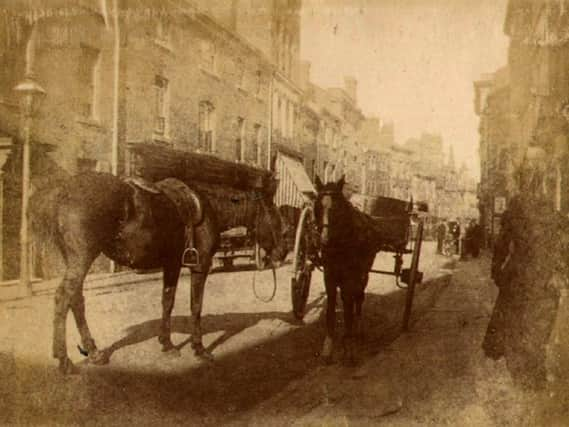Typhoid, tomatoes and Tom Brown's Schooldays - the story of the rise and fall of Rugby, Tennessee


Some time during the autumn of 1955, a film came to Rugby’s Granada cinema that would have a lasting and dramatic effect on my young life.
In fact, such was its popularity, I seem to remember that Davy Crockett: King of the Wild Frontier, starring Fess Parker as the great man himself, was retained for several weeks.
Advertisement
Hide AdAdvertisement
Hide AdI certainly made the most of its stay. Being only six years old, I had to cajole my mother into taking me time and again to the North Street ‘flicks’, although I vaguely remember pal Mick Lucas’s mum doing the honours on one occasion.
The Walt Disney picture had a major effect on the youth of Rugby.
Countless fur coats would be turned into coonskin hats, which were worn without shame or embarrassment by many members of the younger generation as they strode down such dusty frontier trails as High Street or Sheep Street.
The movie also introduced into the consciousness the hitherto fairly unknown American state of Tennessee, this being the birthplace of the man who famously fought and died at the Alamo in 1836.
Advertisement
Hide AdAdvertisement
Hide AdBut little did I know back then that our Warwickshire town also had a namesake in that very state…
Rugby, Tennessee, was established in 1880 as an experimental, utopian community for British expats in the American South. It was to incorporate the best parts of America with the finest parts of England – civilised, hardworking Christians sharing in an agricultural community without rigid class distinctions.
The settlement was located on the Cumberland Plateau near the junction of Morgan, Scott, and Fentress counties. While it straddles the two former counties, the majority of it lies in Morgan County.
Founded by Thomas Hughes, the author of Tom Brown’s Schooldays, this new Rugby thrived at first. It attracted the younger sons of landed British gentry, who, by birthright, received nothing of their fathers’ estates, as well as Americans seeking a planned community and culture.
Advertisement
Hide AdAdvertisement
Hide AdHughes had become disenchanted with the growing materialism of the Victorian age, and was also unhappy with the custom of progeniture, the legal device by which only the elder son in an aristocratic family was entitled to inherit, thereby excluding his younger siblings.
Rugby rapidly became a meeting of minds, and soon the population numbered about 300. The inhabitants enjoyed a variety of highbrow pursuits, such as theatre, croquet, and literary clubs.
Around 70 buildings were constructed in a classic Victorian style, including the Tabard Inn – named after the one in Geoffrey Chaucer’s Canterbury Tales – and a free public library named for the town’s founder, Thomas Hughes, who by that time had become a popular British author.
But there was soon trouble in paradise. A typhoid outbreak killed a number of Rugby residents, and because newspapers were watching the town’s progress the tragedy was widely reported on.
Advertisement
Hide AdAdvertisement
Hide AdThe Tabard Inn burnt down twice in as many decades. The town suffered financial troubles too.
He tried to start a tomato cannery, but the inexperienced farmers were unable to produce enough tomatoes. Newspapers ridiculed Hughes and Rugby, and by 1900 it was nearly deserted, with only a handful of residents remaining.
Sixty years later, a man by the name of Brian Stagg stumbled upon the dilapidated community, and vowed to make it a historic landmark.
By creating the Historic Rugby Foundation, Stagg was able to restore the buildings that still stood and rebuild the ones that had been destroyed, according to their original Victorian design.
Advertisement
Hide AdAdvertisement
Hide AdThese days, Rugby, Tennessee is one part museum, one part town. Nearly 85 people live in the historic homes, and the community is still growing, with plans to build a park and more houses.
The Historic Rugby Foundation hosts tours and events that celebrate traditional Victorian crafts and pastimes.
There are Appalachian storytellers, English dancers, ghost tours, wood whittling workshops, and of course, lots of people in period dress.
The Rugby Colony was listed on the National Register of Historic Places in 1972 and retains several original landmarks, including Christ Church Episcopal, Thomas Hughes Free Public Library and Rugby School.
Advertisement
Hide AdAdvertisement
Hide AdThe library is considered one of the oldest freestanding public libraries remaining in the American South.
However, Thomas Hughes did not end his days in this other Rugby nestling in the Appalachian foothills. He subsequently returned to England, perhaps slightly disillusioned with his social experiment, and died aged 73 from heart failure at Brighton in 1896, where he was buried.
Most people would rightly regard the famous game as being Rugby’s greatest gift to the world, but the town’s other claim to fame just goes to show that its name has spread far and wide beyond our shores… even to the backwoods of Davy Crockett’s Tennessee.
John Phillpott’s third book Go and Make the Tea, Boy! has now been published by Brewin Books and available from the usual outlets.